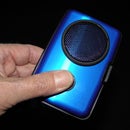Introduction: Solar Power for Zaon MRX PCAS (and Similar Small Electronics Running 2 AA Batteries)
Many airplane and sailplane pilots fly with a small reciever that alerts them when an aircraft with a transponder is getting close to them. The Zaon MRX is a great little example of one of these "Personal Collision Avoidance Systems" (hence the name PCAS). Too bad they don't make them anymore. Well I have one and it is Velcroed to the top of my instrument panel. It works great on AA batteries but they don't last long. I got thinking one day when I saw a 4.5V 95 mA. solar panel for sale at BGmicro.com. The price was great at only $3.95 and so I bought two. I figured one would be enough to keep this charged but if it wasn't two would fit on it. The dimensions of the solar panel are perfect for this instrument. You just replace the AA alkalines with NiMH rechargeables and the sun will keep your device running all day. Sitting up on the instrument panel it gets plenty of sun. Here are the details.
Step 1: Buy and Prepare the Solar Panel
The panel is made from Copper Indium Diselanide for high efficency and is available here:
http://www.bgmicro.com/PWR1241.aspx
Solder some short 4 inch, stranded, insulated wire to the thin tabs on each side of the panel. Take note of which side is positive and which is negative by applying a meter to the tabs while shining light on the other side. Fold the tabs with wires under the panel and use electrical tape to secure the wires to the underside of the panel as shown in the photo.
Step 2: Connect a Diode to the Positive Battery Clip
Take note that one end of the battery compartment has a continuous clip that connects the batteries together and the other end has the seperate positive and negative terminals that feed the battery voltage into the circuitry. Solder a diode to the positive clip with the band printed on the diode (the negative end or cathode) going to the positive terminal. A diode will allow current to flow through from the panel into the batteries but will block outflow from the batteries into the solar panel when it is in the dark. Most diodes will work but it is best if you use a Schottky type that has a lower voltage drop across it such as a 1N5819-1. This will waste a little less power as it has a typical 0.4 Volt drop across it and most silicon diodes have a 0.7 Volt drop. Bend the leads of the diode so that the unsoldered end is accessable for soldering to your panel wire.
Step 3: Secure the Panel to the Top of the Device
There are many ways to do this but I just used a few dabs of GE clear silicone RTV sealant available at home and hardware stores. This is a very handy adhesive and cures like rubber in just a few hours and provides a shock resistant mounting for the glass solar panel. I lined mine up with the top, rear edge of the MRX. Be sure to position the panel so the positive wire is above the side with the diode. Allow to cure before continuing.
Step 4: Connect the Solar Panel Wires
You now may cut the positive wire as short as possible leaving just enough to strip and solder to the positive (anode) end of the diode. Solder it close to the diode and snip off the extra diode lead length. Place some electrical tape over the diode and lead to reduce the chance of damaging it. Now cut and strip the negative panel wire and solder it to the top of the negative battery clip. Be sure to leave the contact area for the battery free and clear so the batteries will still fit.
Charge a pair of NiMH rechargeable batteries (available at many stores including Walmart) and install them into the battery compartment being sure the polaritiy is correct.
Now trim the plastic at the wire end of the battery cover so that the wires will come through the cover. I found that scoring the plastic with a razor knife and snipping it with wire cutters worked well. Cut and fit until the cover fits snugly.
Step 5: Done !
You are ready to use your device. So far I have found that it works as planned with only one solar panel. The MRX has only a few LEDs lit during normal operation until it receives and displays a warning so most of the time the current draw is low and the batteries are being charged. Should your application get less sun or draw more power then simply add the second solar panel and wire it in parallel with the first.
You are now free from changing and buying batteries! Total cost of this project is probably about $10 depending on what materials you have already.

Participated in the
Outside Contest











